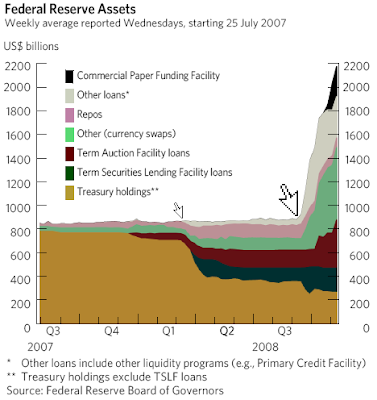Home » Uncategorized (Page 76)
Category Archives: Uncategorized
Country diversification
If history and the current crisis teach us anything, one of the most important lessons is: country's development should not focus on one or two narrow strategies; just like investment portfolio, diversification in development strategies can significantly reduce country risk, putting the country on a smooth growth path.
For this reason, China should move out of its current export-led manufacturing intensive development strategy and allocate more resources to human capital development and improving the quality of its domestic institutions; Russia should not rely too much on its natural resources; India should avoid over-specialization in services.
Because of its heavy reliance on energy export, with crude oil falling over 75% from its peak, Russia is apparently in big trouble now.
Adam Smith told us specialization is good; but over-specialization reverses the benefits of specialization.
Roach: US and Japan, not much difference
Steve Roach, Chairman of Morgan Stanley Asia, thinks the treasuries bubble may go on for a while; There is not much difference between Japan and the US.
For Japan, it had equity and property market twin bubbles plus bad monetary policy; for the US, it also had credit and property market twin bubbles coupled with bad monetary policy. If there is any sign of recovery in 2009, it will be ‘anemic’. (source: Bloomberg)
I am not sure why Roach says monetary policy in the US was bad. Is he referring to Greenspan who kept the rates too low for too long? Or is he referring to the aggressive policies by Bernanke now? The case of Benanke’s policy measures is justified, in my view.
Marvin Goodfriend interview on the Fed’s actions
An interesting and informative piece, touching on many things especially on Fed's future exit strategy. it's an audio clip lasting about 15 mins. (source: Bloomberg)
David Rosenberg interview
David Rosenberg, Chief economist at Merrill Lynch (now part of Bank of America) talks about the Fed’s ZIRP (zero-interest-rate-policy) and the outlook of the housing market. He says Fed’s and government policies just set a cushion to the blow; nothing is guaranteed to work and this recession is nothing like post-War recessions.
David Rosenberg has been a long-time bear; but his predictions so far were all proved correct.
By the way, Rosenberg said days ago, “We are already in a Japan-like lost decade”.
Fed’s balance sheet management
In the latest FOMC meeting announcement, the Fed stressed the need of using its balance sheet as one of the tools to stimulate the economy. Let’s look at the Fed’s balance sheet then in September, October and now.
I bet every central bank facing deflation threat in the world will one way or another print the money. I agree deflation is a bigger threat now, but I am just worried how we will get out of this mess, say 2-5 years from now — Global inflation???
Mankiw: time to abandon ‘price stability’
Fear of deflation outweighs fear of inflation. Greg Mankiw suggests the Fed to abandon 'price stability' in its policy goals. Radical.
From his blog:
Notice this passage in the Fed's press release (emphasis added):
The Federal Reserve will employ all available tools to promote the resumption of sustainable economic growth and to preserve price stability. In particular, the Committee anticipates that weak economic conditions are likely to warrant exceptionally low levels of the federal funds rate for some time.
The phrase "for some time" is aimed at managing expectations in order to keep long-term interest rates down.
The next step for the Fed is to drop the "price stability" rhetoric. The Fed has never been truly committed to stable prices. After all, inflation during the Volcker-Greenspan era averaged about 2 to 3 percent. The Fed could have lowered inflation to zero if it had wanted. Now that zero, or even below zero, is a possibility, the Fed needs to convince people that we are going back to the normal inflation rate of 2 to 3 percent.
Let me suggest this wording for the Fed's next press release:
The Committee recognizes that moderate inflation would be desirable under the present circumstances. In particular, the overall level of prices a decade hence should be about 30 percent higher than the price level today. The committee anticipates keeping the stance of monetary policy sufficiently accomodative to achieve that degree of inflation over the coming decade.
That is, even if the Fed cannot reduce nominal interest rates, it can reduce real interest rates by committing to a modest amount of inflation.
Some would view this as a radical change in monetary policy. In some ways, it would be. Given how weak the economy is, however, a bit of radicalism may be called for. I am more comfortable having the Fed commit itself to modest inflation than having the federal government commit itself to a trillion dollars of new spending. The more we can rely on monetary rather than fiscal policy to return the economy to full employment and sustainable growth, the better off future generations of taxpayers will be.
The abandonment of "price stability" would be the modern equivalent of Roosevelt's abandonment of the gold standard. Of all the things that Roosevelt did to get the economy out of the Depression, jettisoning the gold standard was the most successful. Today, monetary policy is fettered not by gold but by fear of inflation. Perhaps it is time is get over that fear, at least for a while. As Jim Tobin said in an earlier era, there are worse things than inflation, and we have them.


![[Russia's Crisis of Confidence Chart]](https://s.wsj.net/public/resources/images/P1-AO036A_RUSSH_NS_20081218200016.gif)



